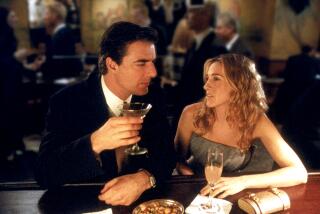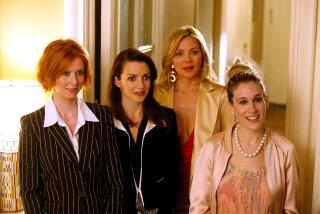Book review: ‘The Carrie Diaries’ by Candace Bushnell
- Share via
If you’re in the neighborhood of Carrie Bradshaw — raised under the influence of the 1970s — then you’re not unfamiliar with the concept behind “Little Archie” comics, the Muppet Babies and Shrinky Dinks: Smaller, if not younger, is cute. And marketable.
So when you first open Candace Bushnell’s “The Carrie Diaries,” which positions the author’s iconic “Sex and the City” character as a high-school senior and fashions her for a teenaged audience, your generational cynicism may prepare you for the worst.
But then, like the reveal at the end of one of the good M. Night Shyamalan movies, it hits you: This is not “Li’l Carrie.” It’s not dumbed-down “Sex and the City.” It’s an origin story. An addictive, ingenious origin story.
When did Carrie become enamored with her name as a fashion accessory? When did she learn to cuss like a pay-cable pistol? What was her passport to the gay nightlife scene? And when and in what city did she first have sex?
Bushnell smartly answers some of the above and more. In “The Carrie Diaries,” we learn that Carrie grew up in an upscale Connecticut town (not unlike her creator), is the eldest of three sisters and is the product of a tender-hearted scientist father and an inspiring homemaker-turned-architect mother, who, in classic literary tradition, abandoned our leading lady through tragic early death.
Helping the 17-year-old Carrie navigate the hallways and mores of Castlebury High are three best friends. No, not those three best friends. Although if you’re a devotee of “Sex and the City” — the TV series and the movies, the latest of which is due in theaters May 27 — it’s impossible to not think of them.
Part of the fun of “The Carrie Diaries” is trying to assign the Charlotte, Miranda and Samantha parts to Lali, Maggie and the Mouse (who’s formally Roberta, but, really, the Mouse’ll do).
The fits aren’t perfect, but who said they were supposed to be? You may even give up looking for Samantha, but don’t. When it dawns on you which classmate has something approximating her spirit, it’s a delicious thrill.
Just as effective are the flashes when aspiring-writer Carrie finds her voice and poses her kind of questions, such as: “How far would you go to get what you wanted?”
The story opens in the fall of 1979. For the young adults at whom “The Carrie Diaries” is aimed, this should make for an entertaining cultural dissonance: Everybody smoked? Boys danced the Hustle without irony? High-school kids knocked back vodkas and Singapore Slings night after night at the neighborhood bar? (Yes, Virginia, from 1972 to 1982, the legal drinking age in Connecticut was 18.)
For older readers, it’s a nostalgic look back on the wild life before helicopter parents took flight. No matter what your age, the brutal high-school social scene should ring painfully and timelessly true.
As in any classic “Sex and the City” plot, Carrie is on a quest for “the big love” — the real, true thing her parents seemingly found. Her Mr. Big is Sebastian Kydd (no apparent relation to Tyler Kidd, a Samantha Jones hook-up from Bushnell’s first book).
Like Big, Kydd is charismatic. Unlike Big, he’s an unenlightened jerk.
In other words, Kydd is a kid, and because this Carrie is one too, she puts up with him until you find yourself begging her fortysomething self to hop in a time machine and lend the girl a spine.
Fortunately, and poignantly, Bushnell lets young Carrie grow one at her own pace.
The joke of “The Carrie Diaries” is that the future “Sex and the City” protagonist is the only one in her group of friends who is, as she delicately puts it, “sexually incomplete.” The brilliance of “The Carrie Diaries” is that the sex is really beside the point.
Instead, the novel is all about the city. Nothing means more to Carrie than a summer slot in the New School’s writing program. It’s a fitting and necessary arc.
After all, “The Carrie Diaries” is an origin story, and at the end of an origin story, the heroine must come to terms with her powers and vow to protect and serve her city. Her Manhattan. Which is what Carrie does.
Ryan is the author of “Former Child Stars.” She is co-writing a book about Christmas in the 1970s.
More to Read
The biggest entertainment stories
Get our big stories about Hollywood, film, television, music, arts, culture and more right in your inbox as soon as they publish.
You may occasionally receive promotional content from the Los Angeles Times.










